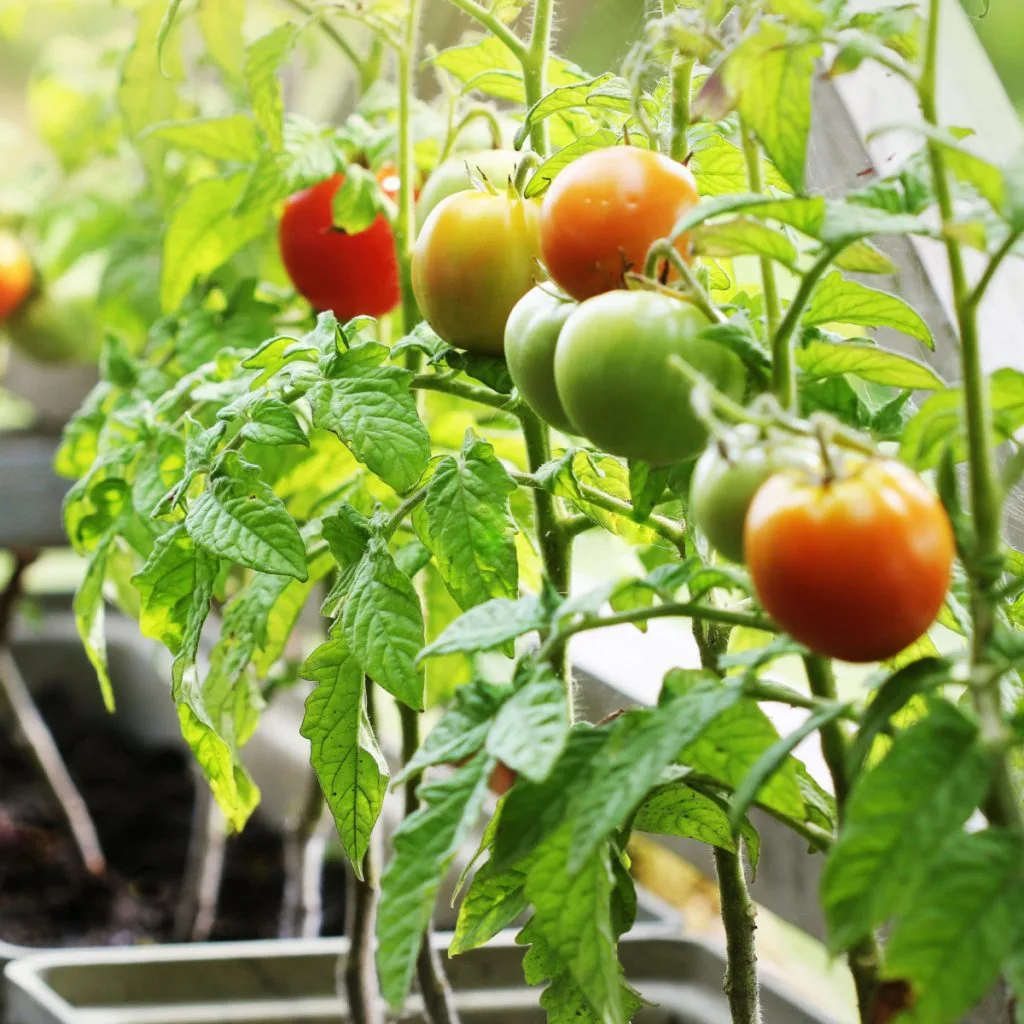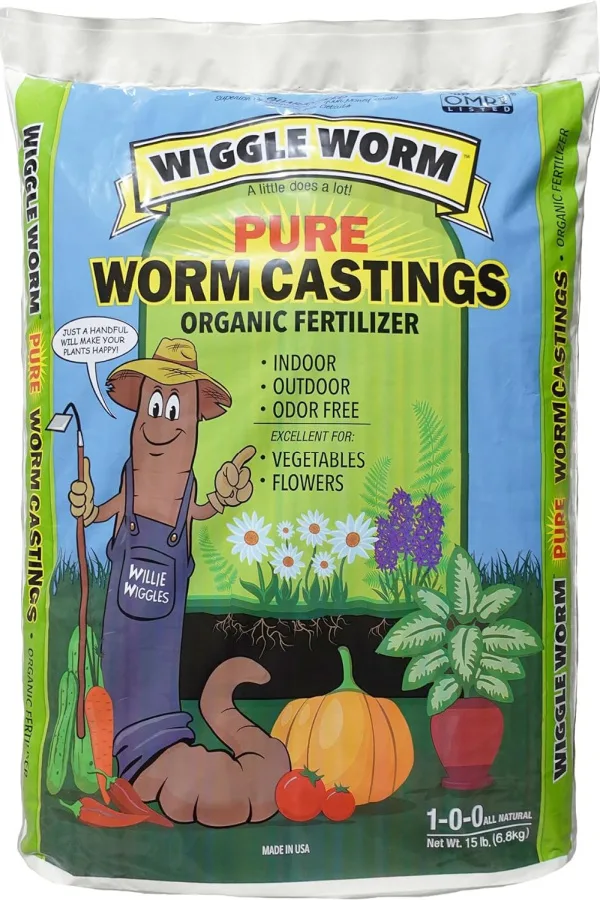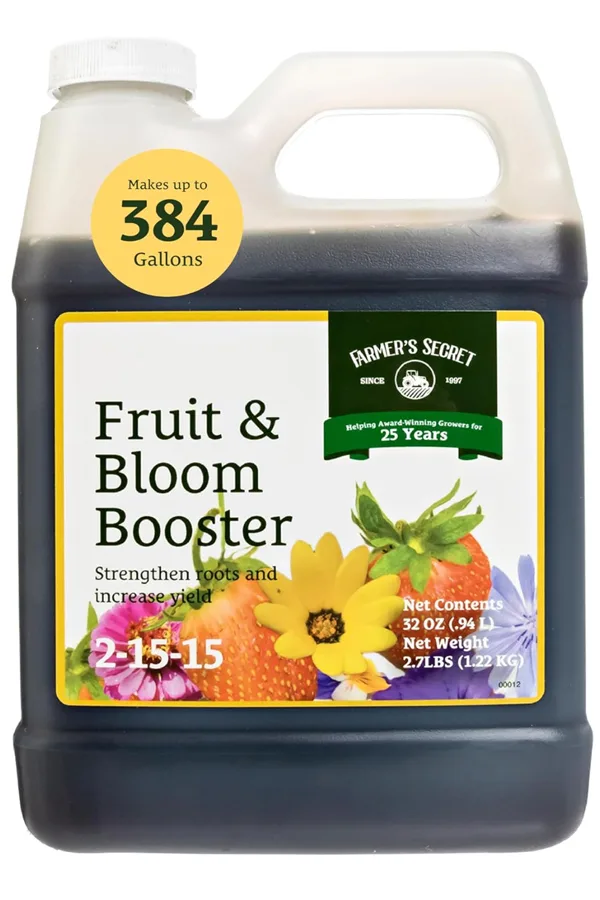Looking for a few simple secrets to fertilize the tomatoes you have growing in containers with the perfect dose of power?
Whether you’re planting on a deck, patio, driveway, or balcony, container tomato plants can grow just as big and produce just as many tomatoes as garden grown plants – as long as they get the nutrients they need. And the only way to make sure they do is to supply them with a regular dose of energy!
When it comes to growing in pots, giving tomatoes the right fertilizer at the right time can make all the difference in the world. Tomatoes are one of the hungriest garden plants you can grow. They require a steady supply of nutrients from the moment they begin to grow, all the way through harvest.

One thing is for sure, if you’re growing tomatoes in containers, keeping those nutrients in the soil can be even harder. That’s because unlike in-ground plants that have access to surrounding soil, container tomatoes are limited to the small amount of soil inside their pots. And they use up what’s available fast!
How To Fertilize Tomatoes In Containers
Giving Your Container Tomatoes The Energy They Need
Tomatoes grown in garden soil can stretch their roots deeper or outward to find more nutrients. But in a container, they’re limited to the soil that’s within a few inches of their roots. Even if you start with rich, fertile potting soil, the nutrients can disappear quickly.
This means once those nutrients are used up, the plant has nowhere else to turn. On top of that, every watering slowly drains nutrients away. And since tomatoes need to be watered often in containers – sometimes daily in hot weather – they lose energy even faster.
Add in the fact that tomato plants need to grow tall, set blooms, and produce large amounts of fruit, and it’s easy to see why they can run out of energy in a hurry. But with just a little bit of smart fertilizing, you can keep your container tomatoes strong and productive all season long.

The good news? Fertilizing tomatoes in pots doesn’t have to be complicated. In fact, it can be simple and highly effective using just two easy methods: a once-a-month top dressing of worm castings and a dose of liquid fertilizer every ten days to two weeks.
These two methods work hand in hand to feed your tomatoes slowly and steadily – and also give them a strong boost when they need it most.
Feeding Tomato Plants Slowly With Worm Castings
One of the best things you can do for your container tomato plants is to feed them a cup of worm castings once a month. It’s an easy process that can provide big-time benefits.
Worm castings are one of the most powerful natural fertilizers you can add to your garden. They’re made from the waste left behind by earthworms as they digest organic matter. But that waste is far from useless – it’s full of nutrients in forms that plants can absorb easily. Even better, it doesn’t burn roots or overload the soil like many synthetic fertilizers can.
To use worm castings on container tomatoes, simply add about one cup of castings to the top of the soil around the base of the plant once every month. As you water, the nutrients slowly soak into the soil and become available to the plant. Affiliate Link: 100% Pure Organic Worm Castings Fertilizer, 15-Pounds.
This “top-dressing” method works especially well in containers because every watering pulls a bit of the castings power down to the roots, giving the plant a slow, gentle feeding every time. See: How To Use Worm Castings To Fertilize Tomato Plants
Worm castings are rich in micronutrients and minerals that promote root development, healthy foliage, and strong plant structure. But more importantly, they help set the stage for better fruit production later in the season.
Since they release nutrients slowly, they keep your tomato plant strong without causing it to grow too fast too early. Another bonus? Worm castings help improve the structure of the potting soil, making it easier for roots to grow and for water to drain properly.
Fertilizing Tomatoes In Containers With Liquid Fertilizer
While worm castings provide steady, slow nutrition, tomato plants also need a more direct and powerful energy source to grow fruit. And that is exactly where liquid tomato fertilizer comes into play.
Starting about 2 weeks after planting your tomatoes, begin using a liquid tomato fertilizer every 10 to 14 days. This type of fertilizer delivers fast-acting nutrients straight to the plant’s roots and foliage, right when it needs a boost to create more blooms and eventually, more tomatoes.
When choosing a liquid fertilizer, it’s important to pick one that’s designed specifically for tomatoes or fruiting plants. These fertilizers usually have a higher amount of phosphorous (the middle number in the fertilizer ratio) and potassium (the third number) compared to nitrogen (the first number). Affiliate Link: Tomato Booster Liquid Fertilizer.
Why does this matter? Nitrogen is important for green growth of the stems and leaves. But too much nitrogen will actually reduce tomato production. If a tomato plant gets overloaded with nitrogen, it will grow big and leafy but produce fewer flowers and fruit. Phosphorous and potassium, on the other hand, are essential for flower and fruit development.
The higher phosphorous helps create more blooms, and potassium strengthens fruit development and disease resistance. With consistent applications, your tomato plants will keep blooming and producing more tomatoes all season long.
To apply the fertilizer, simply follow the directions on the package for mixing with water. Then, pour it around the base of each plant, soaking the root zone thoroughly. Some fertilizers can also be applied as a foliar spray, which lets the plant absorb nutrients through its leaves as well.
A Few Extra Tips For Fertilizing Success
When your tomato plant is still small, don’t start with heavy feeding. Wait until it’s well-established in its container and showing new growth before applying fertilizers. Too much early feeding can shock the plant or push it to grow too fast without strong roots
If your soil is dry, water your plant a little before applying liquid fertilizer. This helps the fertilizer absorb evenly and avoids burning the roots. Remember that consistency is key. Skipping feedings or applying too much at once can result in poor performance.
Even with the best fertilizer, a small container can limit your tomato plant’s success. Aim for pots that are at least 5 gallons or more in size – the bigger, the better. More soil means more room for roots and nutrients to hold.
Last but not least, adding a light layer of compost or straw mulch to the top of the soil after applying worm castings can help keep moisture in and nutrients from washing away too quickly. For more tips on successfully growing tomatoes in containers, see: How To Water Tomato Plants Growing In Containers.
Here is to using a one-two fertilizer approach for you tomatoes in containers. It will give you big results with just a little effort! For more great tomato growing tips, be sure to check out: Tying Up Tomato Plants The Right Way – For A Healthy Harvest.
I Grow Tomatoes
Follow Our Facebook Page For Even More Great Tomato Growing Tips! I Grow Tomatoes Facebook Page
I Grow Tomatoes is a website created for those who love all things about tomatoes – from planting and growing – to cooking and canning! We publish two articles every week, 52 weeks a year. Sign up today to follow via email! This article may contain affiliate links.


